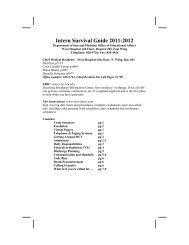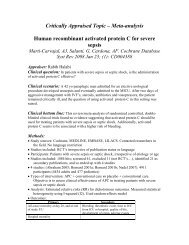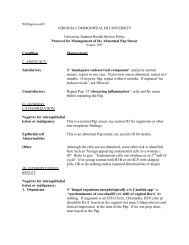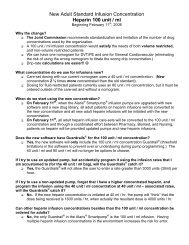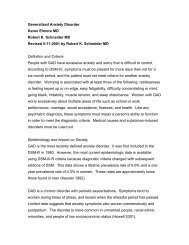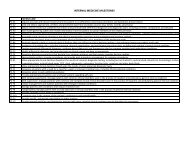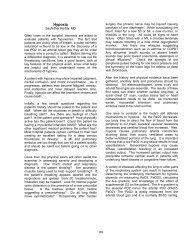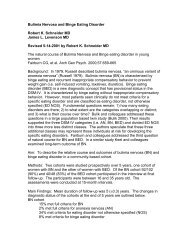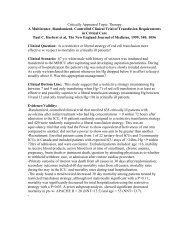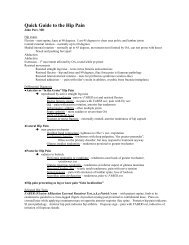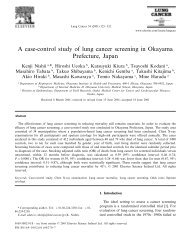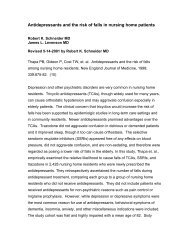BULIMIA NERVOSA Betty Anne Johnson, M.D., Ph.D. Professor of ...
BULIMIA NERVOSA Betty Anne Johnson, M.D., Ph.D. Professor of ...
BULIMIA NERVOSA Betty Anne Johnson, M.D., Ph.D. Professor of ...
- No tags were found...
Create successful ePaper yourself
Turn your PDF publications into a flip-book with our unique Google optimized e-Paper software.
<strong>BULIMIA</strong> <strong>NERVOSA</strong><strong>Betty</strong> <strong>Anne</strong> <strong>Johnson</strong>, M.D., <strong>Ph</strong>.D.<strong>Pr<strong>of</strong>essor</strong> <strong>of</strong> MedicineDirector, University Student Health ServicesMarch, 20011. General Considerations:• Bulimia nervosa (BN) is a syndrome defined by recurrent episodes <strong>of</strong> binge eatingfollowed by inappropriate compensatory behaviors to prevent weight gain (such as selfinducedvomiting, misuse <strong>of</strong> laxatives, enemas, diuretics or diet pills). There is anonpurging type in which individuals compensate for increased caloric intake byepisodes <strong>of</strong> fasting or excessive exercise.• The diagnostic criteria for BN as defined in the Diagnostic and Statistical Manual <strong>of</strong>Mental Disorders, 4th edition (DSM-IV) appears below.• Body image in patients with BN unduly influences self-esteem and these individualsappear preoccupied by weight control.• The refusal to maintain a minimally normal body weight, which is the hallmark <strong>of</strong>anorexia nervosa is not part <strong>of</strong> BN.• BN is more common than anorexia nervosa but less easily detected as patients tend to besecretive about their behaviors and their weights tend to be normal. Two questions thathave proven sensitive when used in the primary care setting for the detection <strong>of</strong> BN are:“Do you ever eat in secret?” and “How satisfied are you with your eating habits?”• The prognosis for BN is better than for anorexia but some authors feel that 30% <strong>of</strong> ptswith BN rapidly relapse and up to 40% remain chronically symptomatic.• The prevalence in the USA is estimated to be 1-3% <strong>of</strong> young adults and growing. It isestimated that 15% <strong>of</strong> high school and college age students will exhibit bulimic behaviorat some time during these years.• The disorder is 10x more common in females than males.• Peak onset is between the ages <strong>of</strong> 13 and 20.• BN appears to have a chronic, sometimes episodic course, in which periods <strong>of</strong> remissionalternate with binge/purge cycles.
DSM-IV Criteria for Bulimia Nervosa1. Recurrent episodes <strong>of</strong> binge-eating. An episode <strong>of</strong> binge eating is characterized byboth <strong>of</strong> the following:a. Eating, in a discrete period <strong>of</strong> time (e.g. within a two-hour period), an amount <strong>of</strong>food that is definitely larger than most people would eat during a similar period <strong>of</strong>time and under similar circumstances.b. A sense <strong>of</strong> lack <strong>of</strong> control over eating during the episode (e.g. a feeling that onecannot stop eating or control what or how much one is eating)2. Recurrent inappropriate compensatory behavior in order to prevent weight gain,such as self-induced vomiting; misuse <strong>of</strong> laxatives, diuretics, enemas, or othermedications; fasting or excessive exercise.3. The binge eating and inappropriate compensatory behaviors both occur, onaverage, at least twice a week for three months.4. Self-evaluation is unduly influenced by body shape and weight.5. The disturbance does not occur exclusively during episodes <strong>of</strong> anorexia nervosa.Specify type:Purging type: during the current episode <strong>of</strong> bulimia nervosa, the person has regularly engaged inself-induced vomiting or the misuse <strong>of</strong> laxatives, diuretics, or enemas.Nonpurging type: during the current episode <strong>of</strong> bulimia nervosa, the person has used otherinappropriate compensatory behaviors, such as fasting or excessive exercise, but has notregularly engaged in self-induced vomiting or the misuse <strong>of</strong> laxatives, diuretics, or enemas.2. Psychiatric Comorbidity• Major depression and BN occur together frequently although it is not yet understood ifthe mood disturbance is a consequence <strong>of</strong> the BN or a separate phenomenon.• Bipolar disorder appears to be more frequent in patients with severe, chronic BN.• 1/3 <strong>of</strong> patients with BN exhibit substance abuse behaviors, particularly <strong>of</strong> alcohol andstimulants. The substance abuse must be addressed before the BN can be effectivelytreated.• 2-50% <strong>of</strong> pts with BN have some sort <strong>of</strong> personality disorder, most frequently borderline,antisocial, histrionic or narcissistic. Pts with BN may be impulsive, not only in theireating behaviors, but also in self-mutilation/self-harm behaviors, sexual promiscuity,lying and stealing.
• Anxiety disorders are also common in pts with BN including panic disorder, obsessivecompulsivedisorder, generalized anxiety disorder, and post-traumatic stress disorder.3. Medical Complications <strong>of</strong> BN• In general, the medical complications <strong>of</strong> BN are a direct result <strong>of</strong> the method <strong>of</strong> purging.Vomiting and laxative abuse are the most common mechanisms <strong>of</strong> purging used.A. Self-induced vomiting:oooMore than 75% <strong>of</strong> bulimic pts use self-induced vomiting. Most patients vomitimmediately or soon after a binge. During the binge, they commonly drinkexcessive fluids to “float the food” and ease regurgitation.Vomiting is induced by placing a finger or a narrow object such as a toothbrush inthe oral pharynx. Some patients learn to vomit by pressure or contraction <strong>of</strong> theabdominal muscles.A minority <strong>of</strong> patients develop reflux following the ingestion <strong>of</strong> almost anyamount <strong>of</strong> food or fluid. This disorder is difficult to treat and requires training thepatient to practice relaxation techniques during eating. There is an associationbetween the rumination syndrome (repetitive regurgitation <strong>of</strong> small amounts <strong>of</strong>food from the stomach after which the food is then partially or completelyrechewed, reswallowed, or expelled) and BN. In one study, 20% <strong>of</strong> patients withBN were found to ruminate and in another study, 17% <strong>of</strong> female ruminators had ahistory <strong>of</strong> BN.B. Medical Complications <strong>of</strong> Self-Induced VomitingooooGastric acids erode dental enamel (perimolysis), especially the occlusal surfaces<strong>of</strong> the molars and the posterior surfaces <strong>of</strong> the maxillary incisors. These changesare irreversible. Enamel erosion occurs in up to 38% <strong>of</strong> bulimics and appears afterapproximately 2 years <strong>of</strong> self-induced vomiting. Pts with severe dental erosioneventually complain <strong>of</strong> tooth sensitivity secondary to exposed dentin.It is unclear whether bulimics have an increased incidence <strong>of</strong> dental caries.Although they <strong>of</strong>ten binge on high sugar content foods, they also appear to takefastidious care <strong>of</strong> their teeth.Cheilosis is a form <strong>of</strong> stomatitis and appears as pallor and maceration at theangles <strong>of</strong> the mouth. Linear fissures can form in severe cases and may form scarsupon healing.Gingivitis may occur from chronic irritation from the acidic gastric contents. Ptscomplain <strong>of</strong> painful, erythematous gums. They do not appear to have an increasedincidence <strong>of</strong> periodontitis however.
ooooooEnlarged salivary glands (sialadenosis) is another complication <strong>of</strong> BN. Thisoccurs in approximately 8% <strong>of</strong> bulimics. Although the etiology is unknown, ptshave painless, bilateral, readily apparent parotid enlargement. Occasionallypatients will have submandibular gland enlargement as well. The frequency andseverity <strong>of</strong> the swelling appears to be proportional to the frequency <strong>of</strong> vomiting.Swelling is usually most apparent 3-6 days after the purging episodes and will<strong>of</strong>ten resolve with regression <strong>of</strong> the purging behavior. The enlargement can betreated with hot compresses or with sucking on tart candies or lemon drops.Occasionally treatment with pilocarpine or parotidectomy has been warranted. 10-20% <strong>of</strong> patients with parotid enlargement will have elevated serum amylase levels(fractionation reveals a salivary origin). These usually resolve after cessation <strong>of</strong>vomiting.Barrett’s esophagus can occur in bulimics although it is unclear whether there isan increased frequency. If a bulimic who induces vomiting complains <strong>of</strong> severedyspepsia not well controlled with a proton-pump inhibitor, upper endoscopyshould be performed because approximately 10% <strong>of</strong> cases <strong>of</strong> Barrett’s willprogress to adenoCA <strong>of</strong> the esophagus.The most serious complication <strong>of</strong> self-induced vomiting is esophageal rupture(Boerhaave’s syndrome). Fortunately, this is rare because mortality is high (20%).Pts complain <strong>of</strong> severe chest pain, painful swallowing, tachypnea and tachycardiaand a L sided pleural effusion may appear on CXR. Prompt surgery is curative.Esophageal and pharyngeal complications: Approximately 50% <strong>of</strong> bulimics willcomplain <strong>of</strong> heartburn, dysphagia or odynophagia from chronic irritation fromgastric contents. In general these will resolve after treatment with a proton-pumpinhibitor. If the patient complains <strong>of</strong> blood in the vomitus, this usually indicates atear in the esophagus which will heal with cessation <strong>of</strong> vomiting. Persistent severepain with blood in the vomitus should be evaluated emergently.Hand trauma can occur if the patient uses her finger to induce vomiting. Bleedinglacerations <strong>of</strong> the knuckles or calloused, scarred areas around the knuckles canindicate bulimic behavior. Oral trauma can occur from use <strong>of</strong> a rigid object suchas a toothbrush to induce vomiting.Some patients induce vomiting with syrup <strong>of</strong> ipecac which can cause severetoxicity if abused. Ipecac is composed <strong>of</strong> 5 alkaloid constituents <strong>of</strong> which emetineand cephaline dominate. Emetine appears to be the most dangerous because itslong half-life (56 hrs) can result in toxic levels if used repeatedly. Most <strong>of</strong> thetoxicity is in skeletal and cardiac muscle. Ipecac cardiomyopathy presents withtachycardia, dyspnea, hypotension and arrythmias and can proceed to heartfailure, ventricular arrythmias and sudden death. The skeletal musclecomplications <strong>of</strong> ipecac abuse include weakness, pain, tenderness and stiffness.
oElectrolyte disturbances: Chloride, potassium, sodium and magnesium are lost influids because <strong>of</strong> excessive vomiting. Hypokalemia in particular may present as amedical emergency. Symptoms include fatigue, muscle spasms or heartpalpitations. More serious complications include paresthesias, tetany, seizures, orcardiac arrythmias. Metabolic alkalosis is also a direct result <strong>of</strong> loss <strong>of</strong>hydrochloric acid in the vomitus.C. Laxative Abuse:oLaxative abuse in bulimics is 3.5x more likely than in the general population. Ofnote is that laxatives actually do little to impair caloric absorption as their primarysite <strong>of</strong> action is in the colon. The primary site <strong>of</strong> caloric absorption is in the smallintestine. Significant weight loss is not achieved through laxative abuse yet it isthe second most common mechanism <strong>of</strong> purging used by bulimics.o There are 5 major types <strong>of</strong> laxatives based on mechanism <strong>of</strong> action:2. Bulk laxatives3. Osmotics4. Surfactants5. Emollients6. StimulantsooThe laxatives most abused by bulimics are the stimulant laxatives and includethose containing phenolphthalein and anthraquinone. They stimulate colonicmotility inducing large volumes <strong>of</strong> watery diarrhea.The medical complications <strong>of</strong> laxative abuse are categorized into thegastrointestinal complications and the systemic complications:1) Gastrointestinal complications <strong>of</strong> laxative abuse:oooMelanosis coli is a dark brown discoloration <strong>of</strong> the colonic mucosa detected oncolonsocopy. There is no known significant pathophysiologic consequence tomelanosis coli. It is seen in approximately half <strong>of</strong> patients taking anthraquinonebasedlaxatives.Functional impairment <strong>of</strong> colonic motility is common resulting in reflexconstipation. If caught early, withdrawal from laxatives results in return <strong>of</strong> normalcolonic function.Cathartic colon is much more serious. Here the colon does not peristalse normallybecause <strong>of</strong> chronic habituation to stimulants. The colon becomes dilated andatonic and on barium enema, the colon has lost its normal haustral markings.Slowed or absent transit occurs resulting in hard, infrequent stools or occasionallya state <strong>of</strong> total constipation. Occasionally this state can become so severe andrefractory that colectomy is required.
2) Systemic complications <strong>of</strong> laxative abuse:oooHypovolemia and electrolyte disturbances are the most common complications <strong>of</strong>laxative abuse. The electrolytes lost in the diarrhea include chloride, calcium,bicarbonate, and potassium. Renal compensatory mechanisms induce a state <strong>of</strong>secondary hyperaldosteronism. Severe diarrhea results in a hypokalemic,hypochloremic metabolic alkalosis complicated by hypovolemia-inducedhyperaldosteronism.Bulimics <strong>of</strong>ten deny laxative abuse. In suspected cases, you may order toxicologicassays <strong>of</strong> feces or urine. In addition, surreptitious use <strong>of</strong> laxatives should beconsidered in cases <strong>of</strong> chronic diarrhea. In one study, up to 15% <strong>of</strong> ptscomplaining <strong>of</strong> chronic diarrhea were found to be using laxatives despite denyingany laxative ingestion.Treatment <strong>of</strong> laxative abuse can be difficult as patients are hypersensitive to therebound constipation and fluid retention which occurs during withdrawal fromlaxatives. Restoration <strong>of</strong> normal bowel function does not occur immediately andpts experience anxiety over the weight gain. Constipation may be treated with amild nonstimulant laxative such as Milk <strong>of</strong> Magnesia or lactulose together with abulk agent such as psyllium. Do not use diuretics to treat the mild fluid retentionwhich occurs. This will resolve within a few weeks with salt restriction and legelevation.D. Diuretic Abuse:oooooooooooDiuretics are used less frequently by bulimics than are laxatives.The 2-4 lb weight loss induced by diuretic abuse is ineffective as a weight lossmeasure as it is followed by reflex fluid retention and the compulsion to continueto use diuretics.Often patients are diagnosed with “idiopathic edema.” One author (Bihun)showed through a self-report questionnaire <strong>of</strong> university women that womendiagnosed with “idiopathic edema” had a 70% increased risk <strong>of</strong> having abnormaleating behaviors compared to women without edema.Prescription diuretics can be classified into several groups:Thiazide diureticsLoop diureticsPotassium-sparing diureticsOTC diuretics contain one <strong>of</strong> three possible drugs:PamabromAmmonium chlorideCaffeine
E. Medical complications <strong>of</strong> diuretic abuse:1. Hypokalemia:ooooooooooooooHypokalemia is the most common and possibly the most dangerous as it caninduce cardiac arrythmias:Sinus bradycardiaSecond and third degree heart blockAtrial flutterVentricular irritability including PVC’s, VT, and VFHypokalemia decreases urinary concentrating abilityElevated creatininePolyuriaPolydipsiaHypokalemia causes skeletal muscle weaknessHypokalemia decreases colonic motilityNauseaConstipationAbdominal pain2. Metabolic alkalosis:oMetabolic alkalosis results from loss <strong>of</strong> hydrochloric acid via vomiting andhypovolemia secondary to diuretics, vomiting, and laxative abuse.o Bulimics develop a pseudo-Bartter’s syndrome with a normotensive,hypokalemic, hypochloremic metabolic alkalosis. The hypokalemia cannot becorrected without concomitant correction <strong>of</strong> the hypovolemic state.o There is <strong>of</strong>ten an associated Mg depletion from the diuretic use which interfereswith repletion <strong>of</strong> potassium.oCessation <strong>of</strong> use <strong>of</strong> purging behaviors <strong>of</strong>ten results in severe edema as theunopposed aldosterone axis continues to cause fluid retention. This should bemanaged with salt restriction, leg elevation and patience although occasionallyprescription <strong>of</strong> a potassium-sparing diuretic to negate the effects <strong>of</strong> aldosterone iswarranted.
Common Electrolyte Changes with Different Purging Modes 1Purging Na K Cl BicarbModeDiuretics or nl Laxatives or nl Vomiting or nl 1 Batal, H et.al. Bulimia: A Primary Care Approach J <strong>of</strong> Women’s Health, 1998;7:216.F. Abuse <strong>of</strong> diet pills• Diet pills are probably the most effective <strong>of</strong> the means <strong>of</strong> weight control but are usedinfrequently by bulimics because <strong>of</strong> their side effects.G. Medical complications <strong>of</strong> diet pills:• Complications <strong>of</strong> diet pills, which in the past usually contained phenylpropanolamine(PPA), included palpitations, anxiety attacks, headaches, elevated blood pressure andseizures. PPA containing products have been withdrawn from the market by the FDAbecause <strong>of</strong> increased risk <strong>of</strong> CVA.H. Diabetes and Bulimia:• Type I diabetics can be bulimic. 30-50% <strong>of</strong> type I diabetics engage in disordered eatingbehaviors for weight control. Whether there is an increased prevalence <strong>of</strong> bulimia amongwomen with type I diabetes or merely an overlap between the two common problems iscontroversial.• Type I diabetics may engage in binge-eating with insulin omission, so called “insulinpurging.” The resultant glycosuria induces an osmotic diuresis for weight control.• The nature <strong>of</strong> Type I diabetes and its management may put women at risk for disorderedeating behaviors:oooooChronic dietary restraintEmphasis on foodFamily dynamics associated with chronic childhood illnessWeight gain associated with tight glycemic controlHandy tool for weight loss (insulin omission)
I. Medical complications <strong>of</strong> insulin purging:• Higher glycosylated hemoglobin levels• Increased episodes <strong>of</strong> hypoglycemia• Increased hospitalizations for DKA• Growth retardation• Pubertal delay in adolescents• Increased microvascular complications, particularly retinopathy4. Treatment <strong>of</strong> Bulimia Nervosa• Treatment <strong>of</strong> bulimia nervosa usually requires a team approach. The team should consist<strong>of</strong> a:• Primary care provider to perform ongoing medical monitoring• Dietician• Therapist (<strong>of</strong>ten a family therapist)• Psychiatrist• Communication among team members is key as <strong>of</strong>ten the patient may intentionally orunintentionally play one team member against another to divert attention fromthemselves.• Occasionally it may appear that the patient makes quick progress but problem behaviorsusually resurface soon so on-going monitoring is recommended.• Role <strong>of</strong> the primary care provider includes assistance with:• Diagnosis• Coordination <strong>of</strong> care among team members• Oversight <strong>of</strong> nutrition to assure adequacy• Managing medical complications• Visits may be weekly, monthly, or daily depending upon the patient. Insurers arereluctant to pay for hospitalization and therefore intensive outpatient therapy may benecessary.• At each visit, physical examination should include:• Orthostatic vital signs• Weight• Laboratory and EKG monitoring as described above
• Patient education is an important part <strong>of</strong> every visit. Emphasize:• Relationship between symptoms/signs and disordered eating behaviors• Potential life-threatening complications• Hospitalization criteria (see Overview <strong>of</strong> Eating Disorders)• Long-term goals (prevention <strong>of</strong> osteopenia, preserving fertility)• Establish a goal weight and then use behavior modification to prevent binge/purge cyclesand still maintain the goal weight.• Encourage the patient to take responsibility for her own meal plan. Mealtimes should notbe a battleground between patient and family.• Dietary needs:• Establish a minimum <strong>of</strong> 2-3 servings <strong>of</strong> protein per day at first and 30-50 g <strong>of</strong> fat for alow fat diet.• 1200-1500 mg calcium daily (3-4 glasses <strong>of</strong> milk, calcium-fortified orange juice orchewable supplements)• Behavior modification can take the form <strong>of</strong> rewards given after each day, week, or monthwithout binging or purging. Have the patient plan the rewards with support from thefamily or friends.• Reasonable exercise prescription can help with weight control and with a feeling <strong>of</strong>general overall well-being.• Bright light therapy (10,000 lux for 30 minutes in the morning) may prove helpful insome patients with a seasonal pattern to their bulimia.• Medications: Fluoxetine (Prozac) has emerged as an effective medication in BN althoughthe dose which was effective (60 mg) is higher than the dose typically used fordepression (20 mg). Medication therapy appears to work better in combination withpsychotherapy (see below).• Psychotherapy: Cognitive-behavioral therapy (CBT) appears to show moderateeffectiveness in the treatment <strong>of</strong> BN. The aims <strong>of</strong> CBT are:1. to re-establish a normal eating pattern, in the place <strong>of</strong> altered eating behavior2. to develop coping techniques in order to avoid eating binges and compensatory behaviors3. to modify cognitive distortions related to body image
5. ReferencesBatal, H. et.al. Bulimia: A Primary Care Approach J <strong>of</strong> Women’s Health, 1998:7:211-220.Bihun JA, McSherry J, Marciano D. Idiopathic edema in eating disorders: Evidence for anassociation. Int. J Eat Disord 1993;14:197.Kaye WH, Klump KL, Frank GK, and Strober M. Anorexia and bulimia nervosaAnnu Rev Med 2000, 51:299-313.Kreipe RE, Birndorf SA Eating disorders in adolescents and young adults. Med Clinics <strong>of</strong> NA,2000; 84:1027-1049.Malcolm, A et al. Rumination Syndrome Mayo Clinic Proc, 1997;72:646-652.McGilley B, Pryor T. Assessment and Treatment <strong>of</strong> Bulimia Nervosa Am Fam <strong>Ph</strong>ysician,1998;57:2743-2750.Ricca V, Mannucci E, Zucchi T, Rotella CM, Faravelli C. Cognitive-behavioural therapy forbulimia nervosa and binge eating disorder. Psychother Psychosom 2000;69:287-295.Rome E Eating disorders in adolescents and young adults: What’s a primary care clinician to do?Cleveland Clinic J <strong>of</strong> Med, 1996;63:387-395.Schwitzer A, Bergholz K, Dore T, and Salimi L. Eating Disorders Among College Women:Prevention, Education and Treatment Response. J Am Coll Health, 1998;46:199-207.Walsh JME, Wheat ME, Freund K. Detection, evaluation, and treatment <strong>of</strong> eating disorders: therole <strong>of</strong> the primary care physician. J Gen Intern Med 2000;15:577-590.



